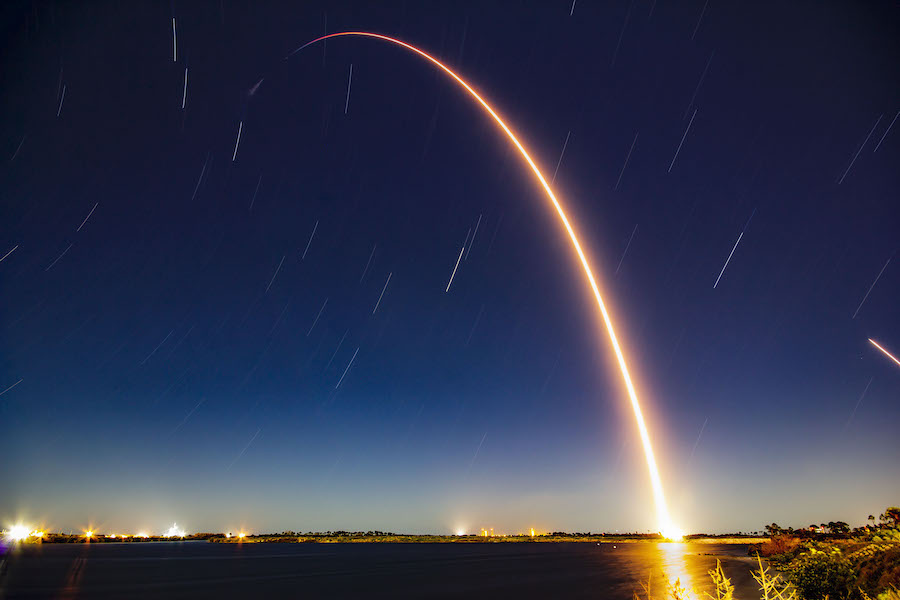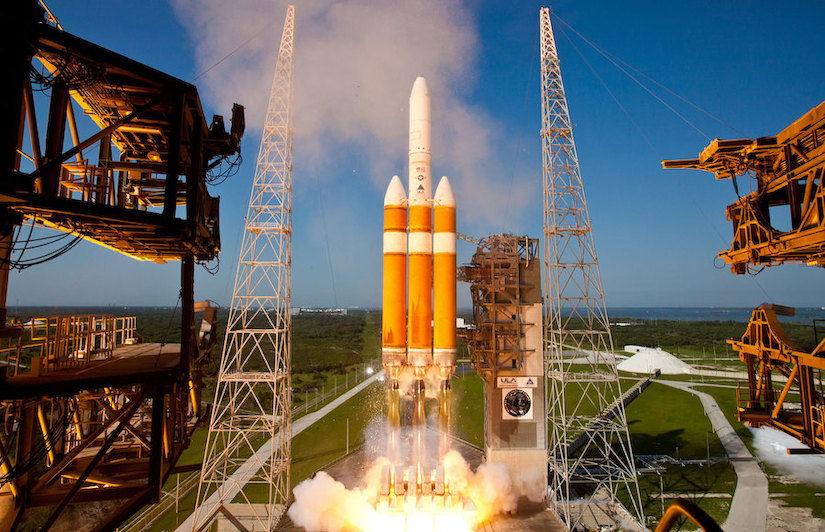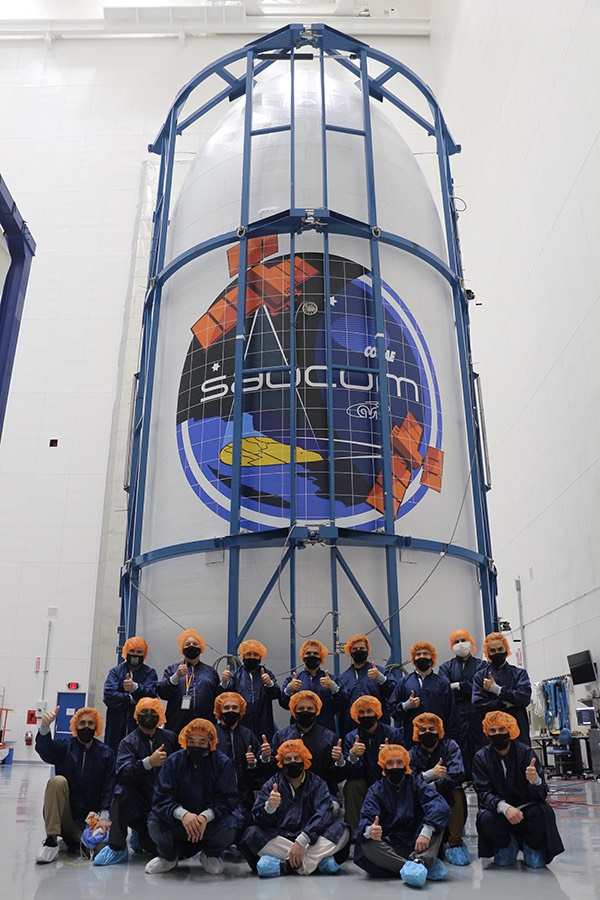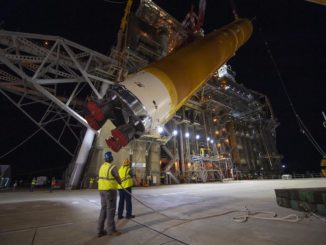EDITOR’S NOTE: Updated at 8 p.m. EDT Aug. 24 with Delta 4-Heavy launch delay.

Launch teams are readying three rockets for a series of blastoffs this week from Cape Canaveral to loft a classified orbiting spy platform for the U.S. government, a long-delayed Argentine radar imaging payload, and the next set of Starlink broadband satellites.
The trio of missions — one by United Launch Alliance and two by SpaceX — could close out August with three rocket launches in a little more than three days. If all three launches get off the ground by the end of August, there will have been 20 orbital rocket launches from Cape Canaveral through the first eight months of 2020.
That puts the Florida launch base on pace for roughly 30 orbital launches for 2020. As always with launch manifests, missions can be delayed or shuffled due to factors such as rocket and payload availability, range scheduling and weather.
A United Launch Alliance Delta 4-Heavy rocket is set for liftoff at 2:12 a.m. EDT (0612 GMT) Thursday from pad 37B at Cape Canaveral Air Force Station. The payload set for launch on top of ULA’s most powerful rocket is a classified satellite for the National Reconnaissance Office, which owns the U.S. government’s fleet of orbiting spy platforms.
The mission was supposed to take off early Wednesday, but ULA announced late Monday that the launch would be pushed back one day due to a request from the mission’s customer.
The Delta 4-Heavy rocket was raised vertical on pad 37B last November to begin a series of checkouts that included a countdown rehearsal during which the launcher was filled with super-cold liquid hydrogen and liquid oxygen propellants.
On July 27, ULA ground crews hoisted the Delta 4-Heavy’s top secret cargo on top of the rocket. Teams spent the last few weeks verifying mechanical and electrical connections between the rocket and the payload.
The mission set for launch early Thursday — codenamed NROL-44 –will mark the 12th flight of ULA’s most powerful rocket since its debut in 2004.
The Delta 4-Heavy is made by combining three Delta 4 rocket core stages together. Each is powered by an Aerojet Rocketdyne RS-68A main engine. An RL10 engine, also made by Aerojet Rocketdyne, powers the Delta 4-Heavy’s cryogenic second stage.
There are five Delta 4 missions left in ULA’s backlog through 2023, including the launch set to go Wednesday. All will use the Delta 4-Heavy configuration.
ULA is retiring the Delta rocket family as the company readies the next-generation Vulcan Centaur rocket for an inaugural test flight next year. The Vulcan Centaur will replace the Delta 4 and the Atlas 5 — ULA’s other rocket family — to haul U.S. military payloads, NASA science probes, and commercial satellites into space.

There is am 80 percent chance of favorable weather for the Delta 4-Heavy’s predawn launch opportunity Thursday, according to the U.S. Space Force’s 45th Weather Squadron at Cape Canaveral.
Assuming ULA’s Delta 4-Heavy takes off Thursday, SpaceX will be next on the U.S. military-run Eastern Range at Cape Canaveral. A SpaceX Falcon 9 rocket was scheduled to launch from pad 40 Thursday at 7:19 p.m. EDT (2319 GMT), but the Delta 4-Heavy mission has priority on the range schedule because it carries a U.S. national security payload.
The 24-hour delay in the Delta 4-Heavy launch will push back the launch of the Falcon 9 rocket until 7:19 p.m. EDT (2319 GMT) Friday, according to sources familiar with the schedule. SpaceX did not immediately confirm what impact the Delta 4 delay might have on the Falcon 9 launch.
The Falcon 9 rocket will launch Argentina’s SAOCOM 1B radar observation satellite, a twin to an all-weather Earth-imaging surveillance platform launched in 2018 on a Falcon 9 mission from Vandenberg Air Force Base in California.
The SAOCOM 1B mission will be the first rocket launch from Cape Canaveral since 1969 to fly on a southerly course to deploy its payload into a high-inclination orbit the flies near Earth’s poles on each lap around planet. The unusual trajectory will require the Falcon 9 rocket to first fly south-southeast from Cape Canaveral over the Atlantic Ocean, then bend its course back to the west in a right turn to skirt the coast of South Florida.
Known as a “dogleg” maneuver, the right turn will ensure the rocket’s impact point never crosses Florida in the event of an in-flight failure that causes the vehicle to crash back to Earth. The launcher will then head over the Florida Straits and Cuba before placing the SAOCOM 1B radar satellite into orbit.
The Falcon 9’s first stage booster will return to landing at Cape Canaveral after completing its nearly two-and-a-half minute firing. It will be the first landing of a Falcon 9 booster at Cape Canaveral since March, following a string of missions during which the reusable Falcon 9 first stage landed on one of SpaceX’s ocean-going drone ships.
Range safety officials began studying the southerly launch trajectory after a wildfire at Vandenberg Air Force Base — where nearly all the U.S. launches into polar orbit originate — threatened launch and payload processing facilities in 2016. SpaceX elected to use the polar launch trajectory from Cape Canaveral to allow the company to reduce staffing levels at Vandenberg during a period with few launches there.
Like its predecessor SAOCOM 1A, the SAOCOM 1B satellite will scan the Earth with an L-band steerable synthetic aperture radar, enabling all-weather imagery of the planet day and night. Radar imagers can see through clouds and are effective 24 hours a day, but optical cameras are hindered by clouds and darkness.
Among other objectives, the SAOCOM satellites are designed to measure soil moisture and collect data for users in Argentina’s agricultural and forestry sectors.
The launch of SAOCOM 1B is set to be the 100th orbital launch attempt in SpaceX’s history, including early missions using the now-retired light-class Falcon 1 rocket.

SAOCOM 1B was previously scheduled for launch in March, but Argentine officials called off the mission due to concerns about the coronavirus pandemic. Engineers placed SAOCOM 1B in storage at Cape Canaveral until early July, when engineers returned to Florida from Argentina to finish readying the spacecraft for liftoff.
The launch of SAOCOM 1B was again delayed from late July because the range was not available for the launch, according to SAOCOM 1B team members. Sources said the delay was likely caused by range safety and overflight concerns with the classified payload mounted on top of ULA’s Delta 4-Heavy rocket at a neighboring launch pad.
The southerly trajectory required for the SAOCOM 1B mission will take the Falcon 9 rocket closer to the Delta 4 pad than for a typical launch toward the east.
After the Delta 4-Heavy launch and the launch of SAOCOM 1B, SpaceX aims to fire another Falcon 9 rocket into orbit from Florida’s Space Coast as soon as Saturday, Aug. 29, with the company’s 12th batch of Starlink broadband satellites. It wasn’t immediately clear whether the Falcon 9/Starlink launch might be pushed back as a ripple effect from the Delta 4-Heavy and SAOCOM 1B delays.
SpaceX has already accomplished two Falcon 9 launches this month — on Aug. 7 and Aug. 18 — each with nearly 60 Starlink satellites for the company’s ever-growing network of relay nodes designed to beam broadband signals to customers around the world.
The launch set for this weekend will take off from pad 39A at NASA’s Kennedy Space Center.
SpaceX has launched 653 Starlink satellites on 11 Falcon 9 rocket missions since May 2019.
Jonathan Hofeller, SpaceX’s vice president of Starlink and commercial sales, said last week that the company is building six Starlink spacecraft per day, and plans to launch Starlink missions at intervals of every two to three weeks until completing the initial Starlink network of around 1,440 satellites.
Email the author.
Follow Stephen Clark on Twitter: @StephenClark1.



